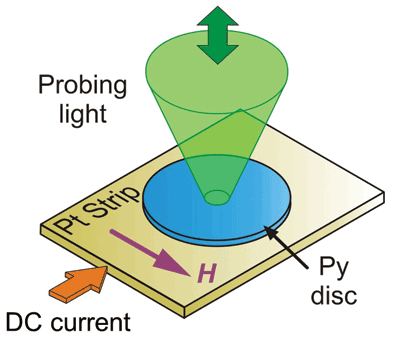Team demos control of magnetic thermal fluctuations using current
A team of researchers from the NIST Center for Nanoscale Science and Technology, the University of Muenster, and West Virginia University has demonstrated control of magnetic thermal fluctuations using current. This development promises insight into the complexity of spin current phenomena and suggests a route for controllably manipulating fluctuations in future magnetic nanodevices. The complete work, reported in the September 2 issue of Physical Review Letters , represents an important step toward manipulating the noise properties of magnetic nanosensors and memory devices.

The team of researchers used microfocus Brillouin light scattering spectroscopy to study the interaction of spin current with magnetic fluctuations in a Permalloy microdisk located on top of a Pt strip carrying an electric current.
The researchers measured the magnetic fluctuations of a 2-µm-diameter disk of a NiFe alloy (permalloy) using microfocus Brillouin light scattering while a current passed through a supporting Pt strip. The current generated a spin current, which was injected into the permalloy disk through its back surface. While the electrons move through the Pt strip, they scatter differently, depending on each electron’s spin. The electrons with “up” spin scatter slightly toward the top surface and the electrons with “down” spin scatter slightly toward the bottom.
This “spin Hall effect” drives a spin current, but not a charge current, into the bottom of the magnetic disk. The researchers were able to show that the thermal fluctuations of the disk’s magnetization are suppressed if the injected spins are parallel to the magnet’s spins, and that the fluctuations are strongly amplified if the injected spins and the magnet’s spins are antiparallel. By changing the current down the Pt strip, the fluctuations were controllably reduced to 0.5 times or increased to 25 times their thermal level. The measured population of the disk’s magnetic excitations is different from a thermal distribution, showing that the effect is not simply cooling or heating. This research gives an insight into the complexity of spin current phenomena and suggests a route for controllably manipulating fluctuations in future magnetic nanodevices. For more information, call Robert McMichael at 301-975-5121.
Christina Nickolas
Advertisement
Learn more about National Institute of Standards and Technology





